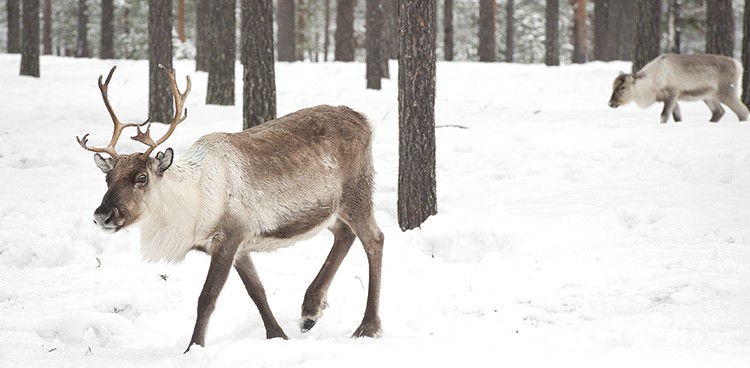
Origin
For tundra-dwelling humans, reindeer have historically been a vital part of life. Those who lived in harsh northern climates depended on reindeer to provide transportation, clothing, meat, and, yes, even dairy. Though reports vary on when reindeer were first domesticated by Arctic people—anywhere from 2,000 to 7,000 years ago—they remain the only deer species to be widely domesticated.
Appearance & Temperament
Reindeer have evolved to survive in the harsh northern tundra they call home, starting with their furry coats. In the summer they have a short coat of hair, only about a quarter-inch long. In the winter they have two coats: a warm, woolly layer closest to the skin, and an outer layer of long, hollow hairs to provide insulation.
Reindeer hooves are circular, with four toes on each foot. These toes can be splayed out when walking on snow or soft ground, which—similarly to snowshoes—more evenly distributes the animals’ weight. The hooves harden in winter, allowing the animal to dig easily through snow and ice to find its favorite food: lichen. Dave Aldrich, owner of Rooftop Landing Reindeer Farm in Clare, Mich., has been breeding and raising reindeer for 23 years. He currently has 20 reindeer on his farm, which he describes as intelligent and friendly.
“They are fairly easy to train to become gentle companions,” Aldrich says, “if they are started at an early age and worked with on a daily basis until they are comfortable with people,” though he admits males are often aggressive during their breeding time (known as “rutting”), when they fight each other over females. The holiday season is a busy time for Aldrich, who rents his deer out for local events and parades. Aldrich makes sure to introduce real-world scenarios to his reindeer, to prevent them from spooking in public. In addition to acclimating them to other animals, such as dogs, “we train them for sirens on fire engines in parades, vehicle traffic, loud noises [like] fireworks, and running and crying children. They accept it all very well.”
Milk & Cheese
Reindeer’s milk is renowned for its high fat and protein content. With a creamlike consistency, reindeer’s milk can have six times the amount of fat and four times the amount of protein as cow’s milk. This makes for an energy-rich drink, important for calves that must keep up with adults’ migration. The milk is also very low in lactose—containing about half of what is found in cow’s milk. So why isn’t reindeer milk better represented in the dairy market? Low milk yields from the deer—an average of four cups a day at peak production, compared to Holsteins’ staggering seven gallons a day—limit availability. However, that doesn’t mean some cultures haven’t found a place for this nourishing milk.
The Finnish cheese juustoleipä (also known as leipäjuusto, which translates to “bread cheese”) is traditionally made with reindeer’s milk. The squeaky cheese, made without a starter culture, begins with fresh curds pressed into blocks, which are then baked to form a browned, caramelized crust. The nonmelting cheese can be eaten cold, but warming it really wakes up the mild, lactic, buttery flavors.
Sid Cook, owner of Carr Valley Cheese Co. in La Valle, Wis., sells a cow’s milk version of this customary Finnish delicacy. Cook loves the multiple uses of the cheese, particularly on greens. “You can break it down into cubes, sauté it, and put it on a salad so that you’ve got a hot-cold thing going, which is very nice… you can have a lot of fun with it.” Indeed, the possibilities are endless: For a traditional experience, do as the Finnish do—dunk the cheese in your morning coffee. For a modern take, slap a slice of bread between two slices of warm bread cheese for a reverse grilled cheese




